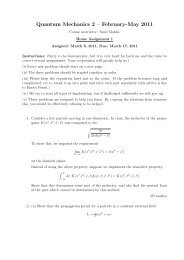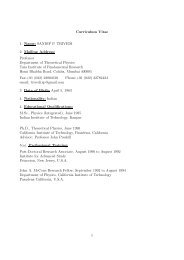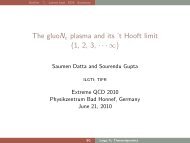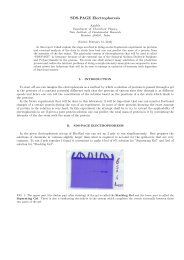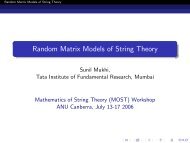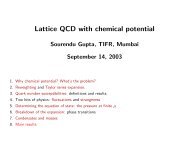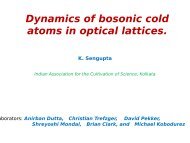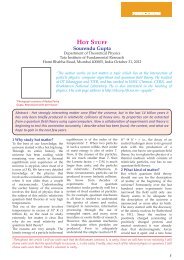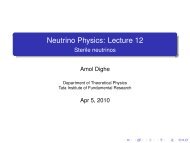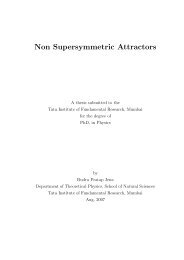How to write (and read) a paper - Department of Theoretical Physics
How to write (and read) a paper - Department of Theoretical Physics
How to write (and read) a paper - Department of Theoretical Physics
You also want an ePaper? Increase the reach of your titles
YUMPU automatically turns print PDFs into web optimized ePapers that Google loves.
Version 2; April 30, 2011<strong>How</strong> <strong>to</strong> <strong>write</strong> (<strong>and</strong> <strong>read</strong>) a <strong>paper</strong>Sourendu Gupta ∗<strong>Department</strong> <strong>of</strong> <strong>Theoretical</strong> <strong>Physics</strong>,Tata Institute <strong>of</strong> Fundamental Research,Homi Bhabha Road, Mumbai 400005, India.A <strong>paper</strong> is a formal means <strong>of</strong> communication between scientists, whose purpose is <strong>to</strong> present apreviously unknown result <strong>and</strong> a complete argument leading up <strong>to</strong> it. In this manual a <strong>to</strong>p-downmethodology is suggested as a <strong>to</strong>ol <strong>to</strong> organize the writing or <strong>read</strong>ing <strong>of</strong> a <strong>paper</strong>. As in any other<strong>to</strong>p-down method, the first step is a short <strong>and</strong> precise statement <strong>of</strong> the result. Successive stepsexp<strong>and</strong> this until the <strong>paper</strong> is <strong>read</strong>y.I. THE NOTION OF A PAPERA <strong>paper</strong> is a means <strong>of</strong> communication between scientists. It is meant <strong>to</strong> be <strong>read</strong>able for years: in some cases forover a hundred years [1]. In order <strong>to</strong> remain underst<strong>and</strong>able for so long, a <strong>paper</strong> must have a formal structure, whichchanges little with fashion. Once you learn <strong>to</strong> use this structure you gain by being able <strong>to</strong> communicate with a largenumber <strong>of</strong> people over many years who are working on problems you are interested in. But, because the form isimportant, training is needed <strong>to</strong> <strong>read</strong> <strong>and</strong> <strong>write</strong> such a document.All formal written scientific communications are not <strong>paper</strong>s. One should distinguish full-length journal <strong>paper</strong>s fromtheir close relatives: letters, reviews <strong>and</strong> conference proceedings. This manual is about the writing <strong>of</strong> a full-lengthjournal <strong>paper</strong>. You will need <strong>to</strong> <strong>write</strong> such <strong>paper</strong>s so that others know what you have done. Your future careerin science depends on the impact <strong>of</strong> your work, <strong>and</strong> <strong>paper</strong>s are usually the medium through which such influencespropagate. The means <strong>of</strong> assessing scientific impact are loose, but the number <strong>of</strong> citations is one <strong>of</strong> the ways whichpeople use for this. Since a badly written <strong>paper</strong> is less likely <strong>to</strong> be <strong>read</strong> or used, <strong>and</strong> hence cited, you must learn how<strong>to</strong> <strong>write</strong> a <strong>paper</strong> well.Modern <strong>paper</strong>s evolved from informal communications between scientists. During the 16th <strong>and</strong> 17th centuries CEformal communication <strong>of</strong> results was through the medium <strong>of</strong> books. <strong>How</strong>ever, news <strong>of</strong> scientific advances was <strong>of</strong>tencommunicated orally by travellers or in letters, usually reaching a large audience <strong>of</strong> peers before the books becameavailable. Over the next centuries these letters became formalized instruments <strong>of</strong> communication. With the rise <strong>of</strong>scientific societies in Europe during the 18th century CE, records <strong>of</strong> oral presentations <strong>to</strong> peers became part <strong>of</strong> theformal process <strong>of</strong> communication <strong>of</strong> results. With the pr<strong>of</strong>essionalization <strong>of</strong> science <strong>and</strong> the adoption <strong>of</strong> the system<strong>of</strong> tenure in universities, the notion <strong>of</strong> a scientific <strong>paper</strong> underwent modification, stabilizing by the end <strong>of</strong> the 19thcentury CE. The form <strong>of</strong> the <strong>paper</strong> (see Appendix A) has undergone little change since then, although the means <strong>of</strong>dissemination <strong>of</strong> <strong>paper</strong>s has been revolutionized in the last few decades due <strong>to</strong> the rise <strong>of</strong> the internet.In this manual I present a technique for writing a <strong>paper</strong> by successive expansion <strong>of</strong> a short core <strong>of</strong> the argumentwhich is <strong>to</strong> be conveyed [2]. The steps in the construction <strong>of</strong> the <strong>paper</strong> can be reversed <strong>to</strong> deconstruct [3] <strong>and</strong> <strong>read</strong>other <strong>paper</strong>s. The approach described here assumes that the decision <strong>to</strong> <strong>write</strong> a <strong>paper</strong> is taken after a clear resultis obtained. Alternative approaches are sometimes espoused in other manuals [4]: the abstract is claimed <strong>to</strong> bediscovered at the end <strong>of</strong> the <strong>paper</strong>, since one does not know what the <strong>paper</strong> might contain until it is written; such a<strong>paper</strong> is better <strong>of</strong>f not being written. I do not discuss style, except very briefly in Appendix B.II. PLANNING THE PAPERThis section <strong>of</strong> the manual describes the process <strong>of</strong> planning the <strong>paper</strong>. Before you get <strong>to</strong> this point, you will havedone a lot <strong>of</strong> work, discussed the material with co-workers, <strong>and</strong> come <strong>to</strong> a decision <strong>to</strong> <strong>write</strong> down your results as a<strong>paper</strong>. So, when you sit down <strong>to</strong> start writing, you have a reasonably complete idea <strong>of</strong> what you want <strong>to</strong> <strong>write</strong>. Thismanual will help you starting from this point.In this section we will discuss how <strong>to</strong> construct three elements <strong>of</strong> the outline <strong>of</strong> the <strong>paper</strong>, namely a working abstract,a s<strong>to</strong>ry-board <strong>and</strong> a working title. We devote one subsection <strong>to</strong> each <strong>of</strong> these elements. Once you construct this plan,∗ Electronic address: sgupta@tifr.res.in
it would help <strong>to</strong> discuss this with your co-authors <strong>to</strong> check whether they agree with the detailed plan. There couldbe changes at this stage, but eventually all authors will agree on a common outline.The notion <strong>of</strong> an outline <strong>of</strong> a <strong>paper</strong> is also very useful when you <strong>read</strong> one. The process <strong>of</strong> extraction <strong>of</strong> an outlinefrom someone else’s <strong>paper</strong> is so useful that I give it a name— deconstruction. It turns out that deconstructing a <strong>paper</strong>is a good way <strong>to</strong> underst<strong>and</strong> it in a <strong>to</strong>p-down fashion.2A. The abstract: the bare bones <strong>of</strong> the <strong>paper</strong>When you start <strong>to</strong> <strong>write</strong> a <strong>paper</strong> you probably have a very good idea <strong>of</strong> what you want <strong>to</strong> say. It is good <strong>to</strong> putthis down in brief, as a reminder <strong>to</strong> yourself, <strong>and</strong> your co-authors. If you have the good fortune <strong>to</strong> have co-authors,sometimes you may be surprised at how many differences can arise over what your main result is.If you <strong>write</strong> this core <strong>of</strong> the <strong>paper</strong> in a formal way then you have something which is known as an abstract. Thiscomes at the beginning <strong>of</strong> a <strong>paper</strong>. It is a short <strong>and</strong> self-contained summary <strong>of</strong> the contents. It is normal practice formany scientists <strong>to</strong> scan through lists <strong>of</strong> abstracts <strong>to</strong> check whether they are sufficiently interested in a <strong>paper</strong> <strong>to</strong> <strong>read</strong>it. So the abstract is very important.An abstract has a brief statement <strong>of</strong> (a) the problem being addressed, (b) the methods used <strong>and</strong> (c) the mainresults. It is a good idea <strong>to</strong> start the act <strong>of</strong> writing a <strong>paper</strong> by writing an abstract. This makes you think about whatthe primary <strong>and</strong> secondary results <strong>of</strong> your <strong>paper</strong> are, <strong>and</strong> how they fit in<strong>to</strong> a subject. This is the briefest outline <strong>of</strong>your <strong>paper</strong>, <strong>and</strong> must be done first. You may come back <strong>to</strong> it later <strong>and</strong> polish it, but start with this.The statement <strong>of</strong> the problem should be completed in one or two sentences, but still be sufficiently detailed thatthe <strong>read</strong>er will underst<strong>and</strong> what you are working on. The only way <strong>to</strong> reconcile these two opposing requirements is<strong>to</strong> make assumptions about what the <strong>read</strong>er knows. Do not insult the <strong>read</strong>er by explaining the obvious, but do notassume so much that only three people in the world can follow your <strong>paper</strong>. The same remarks hold for the description<strong>of</strong> methods. It must be completed in about one sentence, <strong>and</strong> must make sense <strong>to</strong> the target audience. If you havemade changes <strong>to</strong> well-known methods, then mention that.The bulk <strong>of</strong> your abstract, which must be concise, should be a description <strong>of</strong> your results. A good rule <strong>of</strong> the thumbis <strong>to</strong> make this description as long as the other two parts <strong>of</strong> the abstract put <strong>to</strong>gether, i.e., between two <strong>and</strong> foursentences. In order <strong>to</strong> do this, you really have <strong>to</strong> underst<strong>and</strong> your work in its entirety, <strong>and</strong> distill the essence <strong>of</strong> itin<strong>to</strong> the abstract. It is this process <strong>of</strong> thinking hard about your completed work which is important <strong>to</strong> the writing <strong>of</strong>the abstract, <strong>and</strong> a good <strong>paper</strong>.If you have not analyzed the structure <strong>of</strong> a <strong>paper</strong>, then this is a good time <strong>to</strong> look hard at a few <strong>paper</strong>s. No matterwhat the subject matter is, you will find that a modern <strong>paper</strong> begins with an abstract which has the three parts wedescribed. Once you recognize this structure, it helps you <strong>to</strong> quickly underst<strong>and</strong> what a <strong>paper</strong> is about. Here are afew examples. You can find <strong>and</strong> analyze more examples yourself.1. Example 11 Sero<strong>to</strong>nin (5-hydroxytryptamine or 5-HT) is thought <strong>to</strong> regulate2 neurodevelopmental processes through maternalfetal interactions that3 have long-term mental health implications. It is thought that beyond4 fetal 5-HT neurons there are significant maternal contributions <strong>to</strong> fetal5 5-HT during pregnancy, but this has not been tested empirically. To6 examine putative central <strong>and</strong> peripheral sources <strong>of</strong> embryonic brain7 5-HT, we used Pet1/ (also called Fev) mice in which most dorsal8 raphe neurons lack 5-HT. We detected previously unknown differences in9 accumulation <strong>of</strong> 5-HT between the forebrain <strong>and</strong> hindbrain during early <strong>and</strong>10 late fetal stages, through an exogenous source <strong>of</strong> 5-HT which is not <strong>of</strong>11 maternal origin. Using additional genetic strategies, a new technology for12 studying placental biology ex vivo <strong>and</strong> direct manipulation <strong>of</strong> placental13 neosynthesis, we investigated the nature <strong>of</strong> this exogenous source. We14 uncovered a placental 5-HT synthetic pathway from a maternal tryp<strong>to</strong>phan15 precursor in both mice <strong>and</strong> humans. This study reveals a new, direct role16 for placental metabolic pathways in modulating fetal brain development <strong>and</strong>17 indicates that maternalplacentalfetal interactions could underlie18 the pronounced impact <strong>of</strong> 5-HT on long-lasting mental health outcomes.
This abstract <strong>of</strong> a <strong>paper</strong> on developmental biology [5] is a classic example <strong>of</strong> a modern abstract (the lines arenumbered for ease <strong>of</strong> analysis). The first two sentences, ending in line 5, set out the context <strong>and</strong> the problem. Inlines 6–8 one method is discussed <strong>and</strong> the results from this are given in lines 8–11. In lines 11–13 a second method isdescribed <strong>and</strong> the results from this are given in lines 13–15. Finally, the last sentence describes the overall conclusion<strong>of</strong> the <strong>paper</strong>.32. Example 21 We present distance measurements <strong>to</strong> 71 high redshift type Ia supernovae2 discovered during the first year <strong>of</strong> the 5-year Supernova Legacy3 Survey (SNLS). These events were detected <strong>and</strong> their multi-color4 light-curves measured using the MegaPrime/MegaCam instrument at the5 Canada-France-Hawaii Telescope (CFHT), by repeatedly imaging four6 one-square degree fields in four b<strong>and</strong>s. Follow-up spectroscopy was7 performed at the VLT, Gemini <strong>and</strong> Keck telescopes <strong>to</strong> confirm the nature8 <strong>of</strong> the supernovae <strong>and</strong> <strong>to</strong> measure their redshift. With this data set,9 we have built a Hubble diagram extending <strong>to</strong> z=1, with all distance10 measurements involving at least two b<strong>and</strong>s. Systematic uncertainties11 are evaluated making use <strong>of</strong> the multi-b<strong>and</strong> pho<strong>to</strong>metry obtained at12 CFHT. Cosmological fits <strong>to</strong> this first year SNLS Hubble diagram give13 the following results : Omega_M = 0.263 +/- 0.042(stat) +/- 0.032 (sys)14 for a flat LambdaCDM model; <strong>and</strong> w = -1.023 +/- 0.090(stat) +/- 0.054(sys)15 for a flat cosmology with constant equation <strong>of</strong> state w when combined with16 the constraint from the recent Sloan Digital Sky Survey measurement <strong>of</strong>17 baryon acoustic oscillations.The first sentence states the problem tackled in the <strong>paper</strong>. In lines 3–12 one finds a statement <strong>of</strong> the methods used.The rest <strong>of</strong> the abstract is essentially about the results. This abstract comes from an influential <strong>paper</strong> in astrophysics[6] which collected more than 1000 citations in 5 years.3. Example 31 If high energy heavy ion collisions lead <strong>to</strong> the formation <strong>of</strong> a hot2 quark-gluon plasma, then colour screening prevents cc binding in the3 deconfined interior <strong>of</strong> the interaction region. To study this effect,4 the temperature dependence <strong>of</strong> the screening radius, as obtained from5 lattice QCD, is compared with the J/psi radius calculated in charmomium6 models. The feasibility <strong>to</strong> detect this effect clearly in the dilep<strong>to</strong>n7 mass spectrum is examined. It is concluded that J/psi suppression in8 nuclear collisions should provide an unambiguous signature <strong>of</strong> quark-gluon9 plasma formation.This <strong>paper</strong> is another citation classic [7], with well over 1000 citations. It is also a classic example <strong>of</strong> a very clearabstract. The first sentence sets out the problem, the second the method, <strong>and</strong> the last two sentences give the results<strong>and</strong> conclusions.4. Example 41 In a framework <strong>of</strong> the renormalizable theory <strong>of</strong> weak interaction, problems2 <strong>of</strong> CP-violation are studied. It is concluded that no realistic models <strong>of</strong>3 CP-violation exist in the quartet scheme without introducing any other4 new fields. Some possible models <strong>of</strong> CP-violation are also discussed.This is a remarkably elegant abstract from a <strong>paper</strong> which won its authors a Nobel prize [8]. Three brief sentencesmake up the three parts. The first sentence is the statement <strong>of</strong> the problem. The second <strong>and</strong> third sentences set out
the conclusion. The part <strong>of</strong> the second sentence after the word ‘exist’ (see line 3) is the statement <strong>of</strong> the method! Themethod used is quantum field theory, but that phrase, <strong>and</strong> many others are never used. Such elegance <strong>and</strong> extremecompression is made possible by a superb underst<strong>and</strong>ing <strong>of</strong> the audience.4B. The title: advertising your resultOnce you have an abstract, you must compress it further in<strong>to</strong> a title. The title should accomplish two things—first, it should say something about the scientific context, <strong>and</strong>, second, it should say something about the result. Thetitle is like the slogan in an advertisement, so it pays <strong>to</strong> have an accurate <strong>and</strong> catchy title. Remember also that your<strong>paper</strong> will later be found through database searches, so you should try <strong>to</strong> include in the title one or two keywordswhich you think people might search by. You may revise your title at later stages, but do begin with a working title.Here are examples <strong>of</strong> titles, good, bad, <strong>and</strong> ugly—• “A Model <strong>of</strong> Lep<strong>to</strong>ns” [9] implies the context lep<strong>to</strong>ns <strong>and</strong> promises the description <strong>of</strong> a model. This is a superbadvertisement for the solution <strong>of</strong> an outst<strong>and</strong>ing problem which won a Nobel prize. Almost half a century later,we can only improve the title by changing “A” <strong>to</strong> “THE”.• “Preparation <strong>of</strong> fatty acid methyl esters <strong>and</strong> dimethylacetals from lipids with boron fluoridemethanol” [10] hasa detailed description <strong>of</strong> the context <strong>and</strong> implies that the novel element <strong>of</strong> the <strong>paper</strong> is a method <strong>of</strong> preparation.This is not a bad title, since it does its job correctly, but so clumsy that I find it a little ugly.• “The Large N limit <strong>of</strong> superconformal field theories <strong>and</strong> supergravity” [11] just gives the context. It is a badtitle for a work that has been one <strong>of</strong> the most influential in string theory.• “Measurements <strong>of</strong> Omega <strong>and</strong> Lambda from 42 high redshift supernovae” [12] gives the context <strong>of</strong> high redshiftsupernovae with the result advertised as measurements <strong>of</strong> Omega <strong>and</strong> Lambda. The title works, <strong>and</strong> is bothaccurate <strong>and</strong> compressed enough that it is good.C. A s<strong>to</strong>ry-board: organizing the argumentNow that you have decided which part <strong>of</strong> your research your <strong>paper</strong> will highlight, it is time <strong>to</strong> start putting thematerial <strong>to</strong>gether. Before you do any writing, it is good <strong>to</strong> organize your thoughts in some more detail. Film makershave the notion <strong>of</strong> a s<strong>to</strong>ry-board which sets out the script pic<strong>to</strong>rially; this allows them <strong>to</strong> easily move elements arounduntil one has the best possible way <strong>of</strong> telling the s<strong>to</strong>ry. This technique can be adapted <strong>to</strong> writing a <strong>paper</strong>— makeyour material take the place <strong>of</strong> pictures in a s<strong>to</strong>ry-board.This is easiest <strong>to</strong> do if you have lots <strong>of</strong> data. If you do, then elements <strong>of</strong> the s<strong>to</strong>ry-board are figures <strong>and</strong> tables.During the course <strong>of</strong> your work you must have compiled some <strong>of</strong> these. Sit down with the complete set <strong>of</strong> figures <strong>and</strong>tables that you have, look at the abstract, <strong>and</strong> decide which ones illustrate your main conclusions. The s<strong>to</strong>ry-boardworks very well even if your work is highly theoretical. In that case you probably have a lot <strong>of</strong> equations. Select theimportant ones for your s<strong>to</strong>ry-board. Perhaps you have theorems; then the statements <strong>of</strong> the theorem are what youshould have in your s<strong>to</strong>ry-board. Sometimes it is useful <strong>to</strong> take small phrases, such as section titles, as part <strong>of</strong> thes<strong>to</strong>ry-board. No matter what, think hard <strong>and</strong> long about what you would like <strong>to</strong> display on the s<strong>to</strong>ry-board— thesewill be the highlights <strong>of</strong> your <strong>paper</strong>. Finally, when you have everything that you need, make sure that your notationis consistent <strong>and</strong> easy <strong>to</strong> follow.FIG. 1: Examples <strong>of</strong> pic<strong>to</strong>rial representations <strong>of</strong> some highly influential ideas in science: (a) the double-helix structure <strong>of</strong> DNA[13], (b) certain integrals which arise in the treatment <strong>of</strong> the quantum theory <strong>of</strong> light <strong>and</strong> matter, now called Feynman diagrams[14], <strong>and</strong> (c) the causal structure <strong>of</strong> space-time, now called Penrose diagrams [15].
No matter how abstruse your result is, think hard about developing a pic<strong>to</strong>rial representation <strong>of</strong> your primaryconclusions. This is always helpful. Try <strong>to</strong> keep this final figure as nearly self-explana<strong>to</strong>ry as possible, so that themain idea is clear even <strong>to</strong> people who do not <strong>read</strong> your <strong>paper</strong> carefully. Do not clutter the figure: make it convey thesingle most important idea. In the best <strong>of</strong> cases it will be imported by other people in<strong>to</strong> their talks, become parts <strong>of</strong>reviews, <strong>and</strong> eventually become a cultural icon (like the some <strong>of</strong> the images in Figure 1). <strong>How</strong>ever, even if your figuredoes not reach the rarefied heights <strong>of</strong> cult status, time spent thinking <strong>of</strong> a good pic<strong>to</strong>rial way <strong>to</strong> put across your mainresult is never wasted.Once you have the elements <strong>of</strong> your s<strong>to</strong>ry-board, shuffle them around <strong>to</strong> tell a clear <strong>and</strong> logical s<strong>to</strong>ry. When youare satisfied, it is time <strong>to</strong> consult your co-authors with the working abstract, working title, <strong>and</strong> your s<strong>to</strong>ry-board.Lively <strong>and</strong> interesting discussions usually ensue at this point, <strong>and</strong> <strong>of</strong>ten result in changes. At the end <strong>of</strong> this process<strong>of</strong> discussion you will have have an abstract, title, <strong>and</strong> s<strong>to</strong>ry-board which all the authors agree on.Film studios <strong>of</strong>ten have a first cut <strong>of</strong> a film which is shown <strong>to</strong> a small <strong>and</strong> selected audience. Their reactions arefac<strong>to</strong>red in<strong>to</strong> the editing which results in a final cut. It is good <strong>to</strong> adapt this practise <strong>to</strong> your <strong>paper</strong>. Once you havea s<strong>to</strong>ry-board which has the approval <strong>of</strong> your co-authors, try <strong>to</strong> give a seminar <strong>to</strong> your research group or departmentwhich uses the sequence you developed for the s<strong>to</strong>ry-board. Feedback from your immediate colleagues can help you<strong>to</strong> rearrange the s<strong>to</strong>ry-board in a more effective way. While preparing for a seminar you will find that the s<strong>to</strong>ry-boardis the seminar.The rest <strong>of</strong> the job <strong>of</strong> writing will eventually reduce <strong>to</strong> connecting up the elements you put on the s<strong>to</strong>ry-board.That is what we will take up in the next section.5D. Reading a <strong>paper</strong> by deconstructionThe true test <strong>of</strong> a good <strong>to</strong>ol is that it can be easily adapted <strong>to</strong> a slightly different purpose. The <strong>to</strong>ol that wehave built <strong>to</strong> <strong>write</strong> a <strong>paper</strong> certainly can be adapted immediately <strong>to</strong> construct a seminar based on your work. Lessobviously, it also allows you <strong>to</strong> <strong>read</strong> a <strong>paper</strong>.When you are confronted with a new <strong>paper</strong>, you al<strong>read</strong>y have a title <strong>and</strong> an abstract in front <strong>of</strong> you. In the previoussections we have seen how easy it is <strong>to</strong> parse these objects in<strong>to</strong> their constituent parts, even if you know nothing <strong>of</strong>the subject. As a result, you know a little about the context <strong>of</strong> the <strong>paper</strong>, the method used <strong>and</strong> the main resultsobtained.Now you want <strong>to</strong> go a little deeper <strong>and</strong> get an overview <strong>of</strong> the flow <strong>of</strong> the argument presented in the <strong>paper</strong>. Unlikethe analysis <strong>of</strong> the title <strong>and</strong> abstract, this step requires underst<strong>and</strong>ing. You do this by deconstruction, i.e., findinga s<strong>to</strong>ry-board which made up the <strong>paper</strong>. Your s<strong>to</strong>ry-board for the <strong>paper</strong> need not be the one that the authors used.<strong>How</strong>ever, if you <strong>read</strong> through the figures, tables <strong>and</strong> their captions, skim the formulae <strong>and</strong> their explanations, <strong>and</strong><strong>read</strong> quickly through the conclusions, you will be able <strong>to</strong> construct a plausible s<strong>to</strong>ry-board for the <strong>paper</strong>. This is yourfirst <strong>read</strong>ing <strong>of</strong> any new <strong>paper</strong>.Here are some <strong>paper</strong>s which you might want <strong>to</strong> deconstruct—• If you are trying <strong>to</strong> <strong>read</strong> quantum field theory you will need <strong>to</strong> <strong>read</strong> [16], which won its author a Nobel prize.The <strong>paper</strong> is about the modern reformulation <strong>of</strong> quantum field theory, <strong>and</strong> is replete with figures <strong>and</strong> equations.Try <strong>to</strong> put the figures <strong>to</strong>gether with key equations in order <strong>to</strong> make a s<strong>to</strong>ry-board for the <strong>paper</strong>.• If you have any interest in polymers, you will <strong>read</strong> [17] some time. The <strong>paper</strong> has several figures <strong>and</strong> manyequations. It also has a few appendices. Try <strong>to</strong> extract from the <strong>paper</strong> a s<strong>to</strong>ry-board. Does the abstract helpyou in constructing a s<strong>to</strong>ry-board?• If your work involves numerical simulations, then you will <strong>read</strong>, sooner rather than later, the method which wasfirst reported in [18]. The <strong>paper</strong> has a small number <strong>of</strong> tables, figures <strong>and</strong> equations. What s<strong>to</strong>ry-board canyou make out <strong>of</strong> these?• If you are pr<strong>of</strong>essionally interested in cancer, you will need <strong>to</strong> <strong>read</strong> this significant <strong>paper</strong> in the underst<strong>and</strong>ing<strong>of</strong> this pathology [19]. The first third <strong>of</strong> the <strong>paper</strong> is full <strong>of</strong> figures. The remainder has no figures, tables orequations. Extract a s<strong>to</strong>ry-board from this <strong>paper</strong> <strong>and</strong> see which elements <strong>of</strong> the <strong>paper</strong> can contribute <strong>to</strong> as<strong>to</strong>ry-board.Practice in deconstructing a <strong>paper</strong> is a good skill <strong>to</strong> develop. It helps you <strong>to</strong> skim the contents <strong>of</strong> a <strong>paper</strong> at a levelsomewhat deeper than <strong>read</strong>ing the abstract. With practice, the time you will need <strong>to</strong> do such a deconstruction willbecome rather small. Once your have deconstructed a <strong>paper</strong> which you need <strong>to</strong> <strong>read</strong>, you will immediately see howdifferent parts hang <strong>to</strong>gether. This will help you <strong>to</strong> plan how much time you need <strong>to</strong> spend in <strong>read</strong>ing different parts<strong>of</strong> the <strong>paper</strong>. When your skill at deconstruction improves, you will find that preparing <strong>to</strong> give a talk in a journal club
ecomes a breeze. Eventually you will see that in your own area <strong>of</strong> expertise you will seldom need <strong>to</strong> do more, <strong>and</strong>when you do, you will quickly see the parts <strong>of</strong> the <strong>paper</strong> which you need <strong>to</strong> study more deeply.6III. WRITING THE PAPER BY SUCCESSIVE EXPANSIONWhen you have a detailed outline you are <strong>read</strong>y <strong>to</strong> proceed further <strong>and</strong> complete writing the <strong>paper</strong> by successiveexpansion. Al<strong>read</strong>y, in going from the abstract <strong>to</strong> the s<strong>to</strong>ry-board you used the method <strong>of</strong> expansion <strong>to</strong> put in details.Now we push this single method further.A. Captioning the s<strong>to</strong>ry boardAfter you have the outline <strong>read</strong>y, the first step in writing the <strong>paper</strong> is <strong>to</strong> put down captions for the figures <strong>and</strong>tables. There are four kinds <strong>of</strong> information which may be given in a caption, <strong>of</strong> which only the first is m<strong>and</strong>a<strong>to</strong>ry—• A typical caption must have a general description <strong>of</strong> the object.• There may be an explanation <strong>of</strong> the quantities shown, <strong>and</strong> a key which explains things like colour coding, specialnotation, etc..• A caption may have a brief description <strong>of</strong> methods, or a reference <strong>to</strong> a more detailed explanation in the text ora citation.• A caption may also point out some special feature <strong>of</strong> the data, or contrast it with some expectation (this partmay have a reference <strong>to</strong> the text or a citation).At the time you <strong>write</strong> the caption, the rest <strong>of</strong> the text is not yet written, so a reference <strong>to</strong> the text is a reminder <strong>to</strong>yourself that there is some explanation <strong>to</strong> be written down. Keep a list <strong>of</strong> such bits <strong>of</strong> the text: you will fill in theseparts later. Here is where you also keep track <strong>of</strong> things like the notation which needs <strong>to</strong> be explained; put down suchthings in the list <strong>of</strong> bits described above. This is also the time at which you begin a separate bibliographic list, byputting in every citation that you need.What about the s<strong>to</strong>ry-board elements which are not figures or tables? Fill in brief details about these, like notation,special features, previous knowledge etc.. As you do this, build up the list <strong>of</strong> bits <strong>and</strong> the bibliography.Finally, you may have put little phrases in<strong>to</strong> your s<strong>to</strong>ry-board. You could either <strong>write</strong> a small para exp<strong>and</strong>ing thema little, <strong>and</strong> in the process build up the list <strong>of</strong> bits <strong>and</strong> the bibliography, or you could add these items in<strong>to</strong> the list <strong>of</strong>bits.A word about citations: rest assured that many <strong>of</strong> your <strong>read</strong>ers know the literature as well as you do, <strong>and</strong> some <strong>of</strong>them perhaps even better. Incomplete citations will lead them <strong>to</strong> believe that you are re-inventing the wheel. Citeeverything which is important <strong>and</strong> relevant so that the <strong>read</strong>er knows that you know the state <strong>of</strong> the art, <strong>and</strong> thatwhen you claim a new result, then it is very likely <strong>to</strong> be genuinely new.The rest <strong>of</strong> the <strong>paper</strong> will be the expansion <strong>of</strong> the list <strong>of</strong> bits, the bibliography, <strong>and</strong> writing the logic which leadsfrom one figure <strong>to</strong> another. Before proceeding <strong>to</strong> those tasks, it would be good <strong>to</strong> do some case analysis <strong>of</strong> captions.There is, <strong>of</strong> course, a technique <strong>to</strong> captioning. This means that even if you are not very good at it <strong>to</strong> begin with,you can learn <strong>and</strong> become an expert. In order <strong>to</strong> become a real expert, examine <strong>and</strong> analyze as many captions as youcan. To start you <strong>of</strong>f I have collected a few examples <strong>and</strong> commented on them below.1. Example 11 Surface <strong>and</strong> deep expression <strong>of</strong> a mesoscale eddy. (A) Inferred geostrophic2 velocities at the surface <strong>and</strong> the associated time series <strong>of</strong> sea-level3 anomalies (SLAs) from November 2004 <strong>to</strong> May 2005. Two eddies pass during4 this time period: one in February <strong>to</strong> March during the period <strong>of</strong> bot<strong>to</strong>m5 observations <strong>and</strong> a second from the end <strong>of</strong> April <strong>to</strong> May, just after6 the period <strong>of</strong> near-bot<strong>to</strong>m observations. (B) Map <strong>of</strong> SLA on 21 February7 2005 when an anticyclonic eddy made impact with the study site (white8 star). The track <strong>of</strong> the center <strong>of</strong> the eddy from birth on 10 September9 2004 until exit from the study region on 1 May 2005, marked every 4 weeks10 (black circles), is superimposed on the map.
This is a caption <strong>to</strong> a two-part figure from [20]. The first sentence is a general description <strong>of</strong> both. The first sentencefor each part is a general description <strong>of</strong> that part. The second sentence in each part points out a feature <strong>of</strong> interest.The phrases “mesoscale eddy” <strong>and</strong> “near-bot<strong>to</strong>m observations” are clearly elements which will be explained in thetext, <strong>and</strong> therefore would be in the list <strong>of</strong> bits.72. Example 21 Writhe distributions for lp = 50nm <strong>and</strong> lT = 74nm: PWLR(Wr) (green2 dots), Pap(Wr) (red circles), <strong>and</strong> PWLC(Wr) (blue crosses). The chain3 lengths are the following: (a) L = 2000nm, (b) L = 150nm, <strong>and</strong> (c) L4 = 300nm. Note the different scales on the x-axis in the above figures.This caption from [21] begins with a description <strong>of</strong> the content, <strong>and</strong> then gives a key <strong>to</strong> the figure. The secondsentence gives supplementary information. The final sentence points out a feature <strong>of</strong> importance. The phrases“writhe”, “PWLR” <strong>and</strong> “Pap(Wr)” will clearly be part <strong>of</strong> the list <strong>of</strong> bits.3. Example 31 Inferred tree <strong>of</strong> phylogenetic relationships among mormyrid species2 <strong>and</strong> morphs. The phylogeny was estimated by Bayesian analysis <strong>of</strong> cytb3 sequences (values at nodes are posterior probabilities). A sequence from4 the closest outgroup <strong>to</strong> the Mormyridae (Gymnarchus niloticus) was used5 <strong>to</strong> root the tree. Green branches represent a small exterolateral nucleus6 (EL) <strong>and</strong> magenta branches represent an enlarged EL divided in<strong>to</strong> anterior7 <strong>and</strong> posterior subdivisions (ELa/ELp); we reconstructed ancestral states8 using parsimony (see text). Gray outline represents electric organs with9 electrocyte stalks, <strong>and</strong> black outline represents electric organs with10 developmentally labile stalks, based on a previous study (2).The caption from [22] starts with a sentence <strong>of</strong> general description. The second sentence describes the method <strong>and</strong>the remainder is a detailed instruction <strong>of</strong> how <strong>to</strong> <strong>read</strong> the figure <strong>and</strong> is equivalent <strong>to</strong> a key). Note the embeddedreferences <strong>to</strong> the text <strong>and</strong> citations. Apart from these, the phrases “Bayesian analysis”, “EL”, “ELa/ELp” will alsobe in the list <strong>of</strong> bits.4. Example 41 A self-reproducing au<strong>to</strong>ma<strong>to</strong>n <strong>and</strong> a bacterium. (A) Von Neumanns logic. A2 universal construc<strong>to</strong>r (part A) constructs the hardware (part D) <strong>of</strong> the3 <strong>of</strong>fspring au<strong>to</strong>ma<strong>to</strong>n according <strong>to</strong> the instruction I. The copier B makes4 a copy <strong>of</strong> the s<strong>of</strong>tware part <strong>of</strong> the <strong>of</strong>fspring au<strong>to</strong>ma<strong>to</strong>n, the instruction5 tape I. Part A <strong>and</strong> part B are controlled by the regula<strong>to</strong>ry part C. (B)6 Phase contrast microscopy image <strong>of</strong> the division <strong>of</strong> an E. coli cell7 (scale bar: 1 micro-m).This caption extracted from [23] is another two-part figure. The first sentence is a general description <strong>of</strong> the two<strong>to</strong>gether. The first sentence <strong>of</strong> each part is a general description <strong>of</strong> that part. The remainder is a detailed explanation<strong>of</strong> the figure. The phrases “au<strong>to</strong>ma<strong>to</strong>n”, “universal construc<strong>to</strong>r” <strong>and</strong> “copier” will be on the list <strong>of</strong> bits.5. Example 51 In this calculation it is unnecessary <strong>to</strong> choose an explicit set <strong>of</strong>2 coordinates q for the classical phase space. (Such a choice would be3 very awkward in the nonlinear sigma model because <strong>of</strong> the nonlinearity4 <strong>of</strong> the phase space.) It is enough <strong>to</strong> have a basis <strong>of</strong> tangent vec<strong>to</strong>rs
85 <strong>to</strong> the phase space (analogous <strong>to</strong> the tetrad in general relativity). The6 matrices F-tilde <strong>and</strong> F may be constructed relative <strong>to</strong> any such basis. In7 the non-linear sigma model a very convenient basis <strong>of</strong> tangents <strong>to</strong> the8 phase space are the matrices g-inverse times delta g. The matrix F must9 act both on the Lie algebra index <strong>of</strong> g-inverse delta g <strong>and</strong> on sigma.This paragraph from [24], which deals with a mathematical treatment <strong>of</strong> certain quantum field theories, serves thesame purpose as a caption; it explains a certain computation which is displayed after this. The quantities ˜F, F, σ<strong>and</strong> g −1 δg(σ) are clearly on the list <strong>of</strong> bits <strong>to</strong> be explained.B. The definitions <strong>and</strong> methods sectionsThese two parts are now straightforward. The first attempt <strong>to</strong> <strong>write</strong> these sections will start from the list <strong>of</strong> bitsyou have put <strong>to</strong>gether while writing the captions. Put <strong>to</strong>gether little explanations <strong>of</strong> each <strong>of</strong> these items. When yourexplanation is done, take the item <strong>of</strong>f the list. This explanation could be a single sentence like “X was earlier definedin [citation C]” or a short paragraph <strong>of</strong> technical explanation. Unless you are developing a new subject from theground up, most <strong>of</strong> the definitions are fairly st<strong>and</strong>ard, <strong>and</strong> you just need <strong>to</strong> cite the correct <strong>paper</strong>s <strong>to</strong> point peopleat them. There may be just a few definitions which you need <strong>to</strong> extend or re-interpret in some way. Put these downcarefully; add in the reasons for making these redefinitions. If you need <strong>to</strong> add new terminology <strong>to</strong> explain some <strong>of</strong>this stuff, then that goes in<strong>to</strong> the list <strong>of</strong> bits remaining. When the list <strong>of</strong> bits is empty, you have explained everythingthat you need <strong>to</strong>.This is the core <strong>of</strong> the definitions <strong>and</strong> methods sections. Go back <strong>and</strong> take a look at your s<strong>to</strong>ry-board. Some <strong>of</strong>the elements there (equations, figures, tables) may be about methods. Move these in<strong>to</strong> the methods section. Readthrough what you have written once more, polish it up if necessary, change the order <strong>to</strong> a more logical one, polish itup some more, <strong>and</strong>, before you know it you are done with a first draft <strong>of</strong> the definitions <strong>and</strong> methods sections!C. The results sectionOne <strong>of</strong> the best pieces <strong>of</strong> advice about writing <strong>paper</strong>s that I received from my doc<strong>to</strong>ral adviser was <strong>to</strong> leave thebeginning <strong>to</strong> the end [25]. Do that. You al<strong>read</strong>y have the definitions <strong>and</strong> methods sections. If you leave out theintroduction <strong>and</strong> the conclusions, then the rest <strong>of</strong> the <strong>paper</strong> is a set <strong>of</strong> observations leading from one result <strong>to</strong> another.Describe these in sequence. If a step in the argument needs a result established elsewhere, then add a citation <strong>to</strong> that<strong>paper</strong>.The results section <strong>of</strong> your <strong>paper</strong>s will build the core <strong>of</strong> your scientific reputation. The logical presentation <strong>of</strong> solidresults, is what you should aim for, while pointing out what kind <strong>of</strong> care was taken <strong>to</strong> control unknowns <strong>and</strong> howloopholes in logic were plugged, You should also take on the role <strong>of</strong> a guide <strong>to</strong> your <strong>read</strong>ers, as you take them on a<strong>to</strong>ur <strong>of</strong> your s<strong>to</strong>ry-board. You must explain why you s<strong>to</strong>p at a certain element <strong>of</strong> the s<strong>to</strong>ry, <strong>and</strong> then discuss thatelement in sufficient detail. Then you should point out where you will take them next, <strong>and</strong> why.One <strong>of</strong> the most embarrassing things that can happen <strong>to</strong> you is that years after your wrote a <strong>paper</strong>, <strong>and</strong> when yourinterests have changed completely, someone comes up <strong>to</strong> you <strong>and</strong> asks you <strong>to</strong> explain one part <strong>of</strong> it. You could haveforgotten that detail entirely, or you may need quite a bit <strong>of</strong> time <strong>to</strong> reconstruct that argument. To forestall suchevents, <strong>write</strong> down every step: concisely, <strong>of</strong> course, but without omission.Interesting observations which are immaterial <strong>to</strong> the main development <strong>of</strong> your <strong>paper</strong> must go in<strong>to</strong> footnotes orparenthetical paragraphs. Possibly the most famous such remark is the following sentence from the <strong>paper</strong> on thestructure <strong>of</strong> DNA, “It has not escaped our notice that the specific pairing we have postulated immediately suggestsa possible copying mechanism for the genetic material” [13]. Material <strong>of</strong> this sort should not interrupt the main flow<strong>of</strong> your argument.D. The conclusionsWhen I was a young post-doc I was trying <strong>to</strong> convince a famous physicist that work which he had attributed <strong>to</strong>someone else was actually done earlier in one <strong>of</strong> my <strong>paper</strong>s. He <strong>to</strong>ld me something which I’ve come <strong>to</strong> realize is true<strong>of</strong> many others, “When I <strong>read</strong> a <strong>paper</strong>, I go directly from the abstract <strong>to</strong> the conclusions”. In doing this people maymiss the exciting details, <strong>and</strong> the real nitty-gritty <strong>of</strong> research, nevertheless this is what some <strong>of</strong> them do. The reasonis that the formal strcture <strong>of</strong> a conclusion allows them <strong>to</strong> take a dangerous short-cut <strong>to</strong> underst<strong>and</strong>ing.
The conclusion will contain a quick account <strong>of</strong> the logic <strong>of</strong> your arguments <strong>and</strong> can refer back <strong>to</strong> the main s<strong>to</strong>ryboardelements (tables, figures, equations <strong>and</strong> section headings). Some speculation is allowed here. Do not worryabout being <strong>to</strong>o outrageous. If you are, then the referee will surely point it out, unless your co-authors beat you <strong>to</strong> it.Here is a typical modern concluding section from the <strong>paper</strong> which reported the first experimental realization <strong>of</strong>quantum teleportation (dubbed the “Beam me up, Scotty” experiment by news<strong>paper</strong>s) [26]. Note how the first twoparagraphs mix an account <strong>of</strong> the results reported in the <strong>paper</strong> with suggestions for new directions <strong>of</strong> work. The lastparagraph is entirely speculative.1 In our experiment, we used pairs <strong>of</strong> polarization entangled pho<strong>to</strong>ns2 as produced by pulsed down-conversion <strong>and</strong> two-pho<strong>to</strong>n interferometric3 methods <strong>to</strong> transfer the polarization state <strong>of</strong> one pho<strong>to</strong>n on<strong>to</strong> another4 one. But teleportation is by no means restricted <strong>to</strong> this system. In5 addition <strong>to</strong> pairs <strong>of</strong> entangled pho<strong>to</strong>ns or entangled a<strong>to</strong>ms, one6 could imagine entangling pho<strong>to</strong>ns with a<strong>to</strong>ms, or phonons with ions,7 <strong>and</strong> so on. Then teleportation would allow us <strong>to</strong> transfer the state <strong>of</strong>,8 for example, fast-decohering, short-lived particles, on<strong>to</strong> some more9 stable systems. This opens the possibility <strong>of</strong> quantum memories, where10 the information <strong>of</strong> incoming pho<strong>to</strong>ns is s<strong>to</strong>red on trapped ions, carefully11 shielded from the environment.1213 Furthermore, by using entanglement purification---a scheme <strong>of</strong> improving14 the quality <strong>of</strong> entanglement if it was degraded by decoherence during15 s<strong>to</strong>rage or transmission <strong>of</strong> the particles over noisy channels---it16 becomes possible <strong>to</strong> teleport the quantum state <strong>of</strong> a particle <strong>to</strong> some17 place, even if the available quantum channels are <strong>of</strong> very poor quality18 <strong>and</strong> thus sending the particle itself would very probably destroy the19 fragile quantum state. The feasibility <strong>of</strong> preserving quantum states in a20 hostile environment will have great advantages in the realm <strong>of</strong> quantum21 computation. The teleportation scheme could also be used <strong>to</strong> provide22 links between quantum computers.2324 Quantum teleportation is not only an important ingredient in25 quantum information tasks; it also allows new types <strong>of</strong> experiments26 <strong>and</strong> investigations <strong>of</strong> the foundations <strong>of</strong> quantum mechanics. As any27 arbitrary state can be teleported, so can the fully undetermined state <strong>of</strong>28 a particle which is member <strong>of</strong> an entangled pair. Doing so, one transfers29 the entanglement between particles. This allows us not only <strong>to</strong> chain the30 transmission <strong>of</strong> quantum states over distances, where decoherence would31 have al<strong>read</strong>y destroyed the state completely, but it also enables us <strong>to</strong>32 perform a test <strong>of</strong> Bell’s theorem on particles which do not share any33 common past, a new step in the investigation <strong>of</strong> the features <strong>of</strong> quantum34 mechanics. Last but not least, the discussion about the local realistic35 character <strong>of</strong> nature could be settled firmly if one used features <strong>of</strong> the36 experiment presented here <strong>to</strong> generate entanglement between more than37 two spatially separated particles.9E. The introductionYou are now <strong>read</strong>y <strong>to</strong> tackle the most challenging part <strong>of</strong> the <strong>paper</strong>— the introduction. This is the place whereyou point out the context <strong>of</strong> the <strong>paper</strong> <strong>and</strong> showcase your scholarship. There is a certain logic <strong>to</strong> a subject, <strong>and</strong> anynew work rearranges that logic <strong>to</strong> some extent. The introduction is the only place where this very wide view <strong>of</strong> asubject appears. While well-written results <strong>and</strong> conclusions sections build your reputation amongst peers, well-writtenintroductions influence newcomers <strong>to</strong> the field, <strong>and</strong> thereby seal your reputation. Remember New<strong>to</strong>n’s remark aboutst<strong>and</strong>ing on the shoulders <strong>of</strong> giants. The introduction lets other people know whether you are comfortable on such aprecarious perch, or tend <strong>to</strong> slip <strong>and</strong> fall. So give this your best shot, but only when you are done with the rest <strong>of</strong>the <strong>paper</strong>.Here is an introduction I especially treasure [27]. In a four paragraph communication, not quite a <strong>paper</strong>, <strong>and</strong>shorter even than most letters, the authors first set out the context <strong>of</strong> the work brilliantly. At this extreme level <strong>of</strong>
compression, the distinction between an abstract <strong>and</strong> an introduction blurs, but this paragraph does a wonderful job<strong>of</strong> both.1 In a <strong>paper</strong> under this title which has recently appeared, we have2 described <strong>and</strong> discussed observations which have led us <strong>to</strong> the conclusion3 that the light quantum possesses an intrinsic spin equal <strong>to</strong> one Bohr4 unit <strong>of</strong> angular momentum. In the four weeks which have elapsed since5 that <strong>paper</strong> was put in<strong>to</strong> print, the experimental technique has been much6 improved in the direction <strong>of</strong> attaining greater precision. It appears7 desirable forthwith <strong>to</strong> report our newer results, which confirm the8 conclusion stated above.10IV. SUMMARYThere are many ways <strong>to</strong> approach the writing <strong>of</strong> a <strong>paper</strong>. Here I have set out a <strong>to</strong>p-down method <strong>of</strong> writing a <strong>paper</strong>by successive expansion <strong>of</strong> a core argument. The process starts by putting down a very compressed account <strong>of</strong> the<strong>paper</strong> in the form <strong>of</strong> an abstract <strong>and</strong> a title. This is followed by an expansion <strong>of</strong> the argument in<strong>to</strong> a s<strong>to</strong>ry-board, whichconsists <strong>of</strong> the main results <strong>to</strong> be displayed in the <strong>paper</strong>. These elements <strong>to</strong>gether comprise the plan <strong>of</strong> the <strong>paper</strong>.Such a plan is easily adapted <strong>to</strong> the job <strong>of</strong> creating a seminar presentation, <strong>and</strong> is almost exactly the presentationitself.The plan is then exp<strong>and</strong>ed in<strong>to</strong> the <strong>paper</strong> using the same <strong>to</strong>p-down method by filling in captions, links in thearguments which lead between the elements <strong>of</strong> the s<strong>to</strong>ry-board <strong>and</strong> so on, until all the steps in the argument are eitherwritten down in detail or delegated <strong>to</strong> cited <strong>paper</strong>s. This leaves the writing <strong>of</strong> the conclusions <strong>and</strong> the introduction,about which I say a few words.The inverse process <strong>of</strong> <strong>read</strong>ing a <strong>paper</strong> is one I have named deconstruction. It consists <strong>of</strong> orienting yourself by theabstract <strong>and</strong> title <strong>and</strong> using these <strong>to</strong> extract a s<strong>to</strong>ry-board from a <strong>paper</strong>. Just as a s<strong>to</strong>ry-board <strong>of</strong> your own <strong>paper</strong>needs little expansion <strong>to</strong> make a seminar, the s<strong>to</strong>ry-board <strong>of</strong> someone else’s <strong>paper</strong> is also almost enough material <strong>to</strong>make a seminar out <strong>of</strong>. Once a s<strong>to</strong>ry-board is extracted for a <strong>paper</strong> being <strong>read</strong>, it becomes clear which parts <strong>of</strong> theargument are general background knowledge in the field, <strong>and</strong> which are specific advances due <strong>to</strong> the <strong>paper</strong> understudy. Practice in deconstruction <strong>of</strong> <strong>paper</strong>s is an essential skill for any scientist.To repeat, a <strong>to</strong>p-down methodology is very well suited for writing <strong>paper</strong>s. Various parts <strong>of</strong> <strong>paper</strong>s have very formalstructures, which have been described in this manual. A central process in the <strong>read</strong>ing <strong>and</strong> writing <strong>of</strong> <strong>paper</strong>s is thecreation <strong>of</strong> a s<strong>to</strong>ry-board. This is hidden structure in a <strong>paper</strong>, which is elaborated while writing, <strong>and</strong> needs <strong>to</strong> bediscovered when <strong>read</strong>ing.Appendix A: The parts <strong>of</strong> a <strong>paper</strong>A full-length research <strong>paper</strong> consists <strong>of</strong> the following elements, listed in the order in which they appear—1. The title, which is a short description <strong>of</strong> the subject <strong>of</strong> the <strong>paper</strong>.2. A list <strong>of</strong> authors <strong>and</strong> their affiliations. In this manual I do not discuss this aspect <strong>of</strong> the <strong>paper</strong>.3. The abstract, which is a short outline <strong>of</strong> the argument <strong>of</strong> the <strong>paper</strong>. It contains a brief description <strong>of</strong> the contex<strong>to</strong>f the work, the methods used <strong>and</strong> the major conclusions reached.4. Classification keys used for electronic information retrieval, such as report Numbers, keywords or formal indexitems, for example, PACS (<strong>Physics</strong> <strong>and</strong> Astronomy Classification Scheme) numbers. These are becoming lessimportant as algorithms for extracting these elements directly from the <strong>paper</strong> improve.5. The body <strong>of</strong> the <strong>paper</strong>, which is divided in<strong>to</strong> several sections. Usually(a) The introduc<strong>to</strong>ry section, which is a short survey <strong>of</strong> the field, whose purpose is <strong>to</strong> outline the context inwhich the work is being reported.(b) The definitions <strong>and</strong> methods sections, which present detailed definitions <strong>and</strong> describe clearly, completely,but concisely, the methods used in the work. The two sections may be merged in<strong>to</strong> one if either is shortenough.
(c) The results section, which should normally display <strong>and</strong> state the results with objectivity <strong>and</strong> the minimum<strong>of</strong> interpretation (a task which is delegated <strong>to</strong> the conclusions).(d) The conclusions, which gives a brief outline <strong>of</strong> the conclusions reached, places them in<strong>to</strong> context <strong>of</strong> previousknowledge, <strong>and</strong> may speculate on new directions opened out by the work.6. Acknowledgements, if any. It is <strong>of</strong>ten necessary <strong>to</strong> acknowledge grants <strong>and</strong> funding bodies. There is no discussion<strong>of</strong> this aspect <strong>of</strong> <strong>paper</strong>s in this manual.7. The list <strong>of</strong> citations, cross linked in<strong>to</strong> the body <strong>of</strong> the <strong>paper</strong>.11Appendix B: StyleThe style <strong>of</strong> a <strong>paper</strong> is eventually your own, but most journals impose some constraints. While some <strong>of</strong> theseconstraints vary from one journal <strong>to</strong> another, here are some points which are very common—1. The language used should be simple in order <strong>to</strong> reach far in space <strong>and</strong> time. English is the common language<strong>of</strong> science in our era, <strong>and</strong> therefore used by scientists with different levels <strong>of</strong> skill in the language.2. Discussions are not descriptions. When you present the discussion <strong>of</strong> a result, it should not merely be adescription <strong>of</strong> a graph which is presented. Ruthlessly remove such sentences. Consider what more you have <strong>to</strong>say.3. Avoid the subjective. If you are unsuccessful with an approach, simply say that, instead <strong>of</strong> “We felt method Ais unsuitable”. If you have an argument that method A is indeed unsuitable, then give it. But do not expressyour feelings about the method.4. Delete adjectives. After giving vent <strong>to</strong> your elation by writing “Exciting conclusions about X were reached”,quietly go back <strong>and</strong> delete the word “exciting”. The most prestigious journals will actually do this for you ifyou don’t have the heart <strong>to</strong>.5. The passive voice was once widesp<strong>read</strong>, but its dominance is eroding. “We observed that · · ·” is more modernthan “It was observed that · · ·”. If you are uncomfortable with the singular “I observed that · · ·”, do noterroneously substitute “we” for “I”. Instead, consider moving <strong>to</strong> the passive voice.Style manuals <strong>of</strong> many journal are publicly available [28].[1] S. Arrhenius, Phil. Mag. <strong>and</strong> J. Sci., Ser 5, 41 (1896) 237, has recently become a widely <strong>read</strong> reference in climate science.[2] This is an extrapolation <strong>of</strong> a method developed <strong>to</strong> communicate with computers in N. Wirth, Comm. ACM, 14 (1971)221.[3] While this word <strong>and</strong> the process it describes may have some superficial similarity <strong>to</strong> the sense in which it is used in literarycriticism, the aim here is different. For a partial explanation <strong>of</strong> the meaning that this term has in criticism, see Letter <strong>to</strong>a Japanese Friend by J. Derrida in Derrida <strong>and</strong> différance, by D. C. Wood <strong>and</strong> R. Bernasconi, Northwestern UniversityPress, 1988 (also available at http://lucy.ukc.ac.uk/Simulate/Derrida deconstruction.html)[4] See, for example, the Rice biolabs manual: http://www.ruf.rice.edu/ bioslabs/<strong>to</strong>ols/report/reportform.html[5] A. Bonnin et al., Nature, 472 (2011) 347.[6] P. Astier et al., eprint astro-ph/0510447.[7] T. Matsui <strong>and</strong> H. Satz, Phys. Lett. , B 178 (1987) 41.[8] M. Kobayashi <strong>and</strong> T. Maskawa, Prog. Theor. Phys. , 49 (1973) 652.[9] S. Weinberg, Phys. Rev. Lett. 19 (1967) 1264.[10] W. R. Morrison <strong>and</strong> L. M. Smith, J. Lipid Res., 5 (1964) 600.[11] J. Maldacena, Adv. Theor. Math. Phys., 2 (1998) 231.[12] S. Perlmutter et al., Astrophys. J. 517 (1999) 565.[13] J. D. Watson <strong>and</strong> Crick, Nature, 171 (1953) 737.[14] R. P. Feynman, Phys. Rev. 76 (1949) 769.[15] B. Carter, Phys. Rev. 141 (1966) 1242.[16] K. G. Wilson, Phys. Rev. , D 10 (1974) 2445.[17] P. G. de Gennes, J. Chem. Phys., 55 (1971) 572.[18] N. Metropolis et al., J. Chem. Phys., 21 (1953) 1087.
[19] J. F. R. Kerr, C. M. Winterford, B. V. Harmon, Cancer, 73 (2006) 2013.[20] D. K. Adams et al., Science, 332 (2011) 580.[21] S. Medalion, S. M. Rappaport <strong>and</strong> Y. Rabin, J. Chem. Phys. 132 (2010) 045101.[22] B. A. Carlson et al., Science, 332 (2011) 583.[23] V. Noireaux, Y. T. Maeda, A. Libchaber, Proc. Nat. Acad. Sci., 108 (2011) 3473.[24] E. Witten, Comm. Math. Phys. 92 (1984) 455.[25] B. Banerjee, private communication.[26] D. Bouwmeester et al., Nature, 390 (1997) 575.[27] C. V. Raman <strong>and</strong> S. Bhagavantam, Nature, 129 (1932) 22.[28] http://www.nature.com/nphys/journal/v3/n9/full/nphys724.htmlhttps://authors.aps.org/STYLE/12






